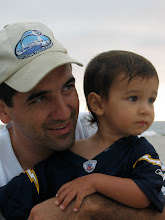May 6, 2009
Maren Blue Demian was born on May 6, 2009. She weighed in at 8 pounds 4 ounces, 20 inches in length.
Maren was born with a Congenital Heart Defect (CHD) called Pulmonary Atresia with Intact Ventricular Septum (PAIVS). This is an extremely rare defect - even among CHDs - and a very serious condition for which the prognosis was grim as recent as 10 years ago. In the U.S. approximately 7.5 in 100,000 babies are born with PAIVS; in Great Britain and Ireland the number is approximately 4 in 100,000. This means that approximately 300 of the 4,000,000 babies born in 2009 in the U.S. will have PAIVS. The prognosis for PAIVS is much improved in recent years, which is attributable to improved treatment plans as well as medical advances.
A CHD describes a condition where a baby is born with a heart that did not form properly during the pregnancy. There is no one identifiable cause for a CHD. They are not predicted by either environmental or genetic factors. Rather, they are multi-factorial in origin. CHDs range from minor (requiring no medical intervention), severe (requiring immediate heart transplant), and everything in between.
The heart forms around the 5th week of the pregnancy, or 3 weeks following conception. In a baby with PAIVS, the pulmonary valve does not form properly and seals off completely, blocking flow through the heart. This blockage results in, among other things, an undersized and underdeveloped right ventricle and tricuspid valve. This condition can have many additional impacts, but the former issues are the primary focus, and have been and continue to be the focus with Maren.
Note, the sealed off pulmonary valve while in utero, does not prevent the fetus's heart from beating and circulating blood, because the blood circulation does not involve the lungs, and is mixed at that time via the foramen ovale, which connects the right atrium with the left atrium, and the ductus arteriosus (PDA), which is a small connection between the pulmonary artery and the aorta. Following birth, when the lungs are kicked into operation, these openings close, and blood is thereafter circulated via two separate avenues: as red blood, pumped from the left ventricle and out to the body, and thereafter returning as blue blood to the right ventricle; and blue blood, pumped from the right ventricle into the lungs, where it is oxygenated and becomes red blood.
http://www.childrenshospital.org/az/Site636/mainpageS636P0.htmlA PAIVS heart can be seen at:
http://www.americanheart.org/presenter.jhtml?identifier=1303A Normal Heart can be seen at:
http://www.americanheart.org/presenter.jhtml?identifier=770See also this one minute British Heart Foundation video:
http://www.youtube.com/watch?v=ep4cQrYFL0wAt birth, a baby with PAIVS is blue, as was Maren. (As will be discussed in a separate post, this is not the source of her name, although it turns out to be fitting.) The first breath of oxygen is a little different for a PAIVS baby. Initially, there is mixing of blue blood into the red blood heading out to the body that reduces oxygen and causes a dusky appearance. Maren started to breathe within seconds, and her color quickly returned.
She scored 8-9 APGARs with the only mark down for the color prior to her getting her breathing going. At that point, all was well in the world. We were sent to recovery, where, even as friends and family started to gather, our recovery nurse, Rusty, heard a loud heart murmur and started the ball moving that would save Maren's life that day. Maren quickly escalated through the system, was put in a little oxygen tent, had her oxygen levels tested (they were low 80s; which is cause for concern, but not so low as to cause damage) and was reviewed by the on call cardiologist. Within a few hours Maren was taken away, placed in a rolling pram/incubator and evacuated down the road to the NICU at Rady's Children's hospital for an echocardiogram. Little Maren was administered an IV of PGE, and referred for further testing. At that point, her pulmonary valve being completely sealed, the PDA is the ticket to survival. PGE is a wonder drug that has the effect of keeping the PDA open, which was the lifeline by which our precious Maren would stay alive that first day. I followed after her to Rady's with Jessica stuck in recovery, arriving around midnight to observe a fellow (cardiologist in training) performing an echocardiogram; to get some sketchy results from the fellow on the spot about the structure of Maren's heart; and then went back to Jessica to try to explain, in a daze, around 3 in the morning, that our world was on its head.





